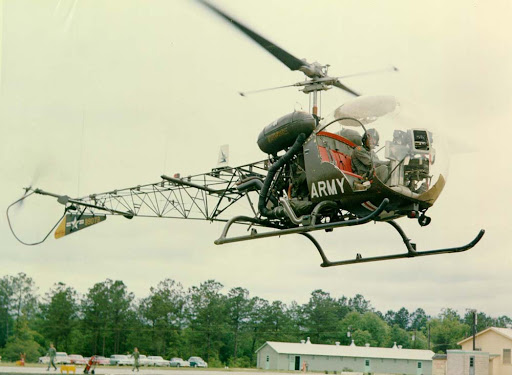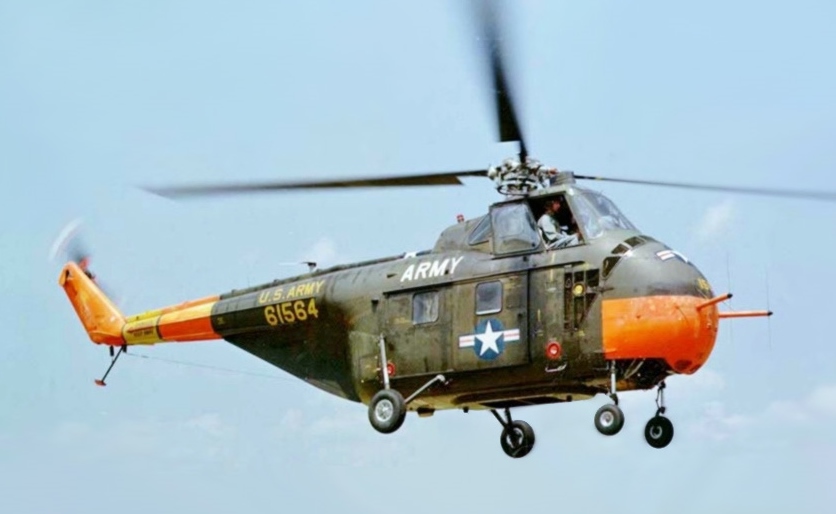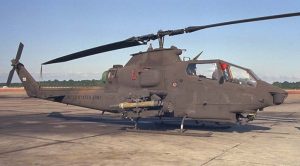Aircraft assigned to the Ohio AASF #2
OH 23 Hiller

The Hiller UH-12, derived from the Model 360 two-seater of 1948 with a 180hp Franklin engine, occupies an important place in the history of the American helicopter industry in the fifties. Stanley Hiller Jr., who built the aircraft, was something of a whiz kid, in that he designed and built his first helicopter, the XH-44, in 1944 at the age of only 18. It was the first efficient American helicopter with coaxial, contra-rotating rotors. The later Hiller 360 leapt to fame in the summer of 1949 when it made the first transcontinental commercial flight. With an uprated engine and new UH-12A rotor blades, it was purchased by the US Army and Navy for battlefield evacuation and observation tasks, with the designation H-23 Raven, whilst the Navy ordered the same basic model as the HTE-1 for training.
Its successor, the H-23B, powered by a 200-210hp Franklin engine, was the first version used by the US Army as a trainer. A considerable number were built: 216 were assigned to the Primary Flying School at Fort Walters and another 237 were single-textused for various tasks.
The UH-12B normally had skid or flotation gear, but a wheeled undercarriage was fitted to a batch ordered by the US Navy (the HTE-2). In 1955 a new variant, the UH-12C, appeared. It retained the 200hp Franklin engine, but had all-metal rotor blades and a “goldfish bowl” cockpit canopy. From 1956, 145 were delivered to the US Army as the H-23C. A purely military version, the OH-12D, flew on 3 April 1956 and 483 went to the US Army. The Franklin engine had been replaced by the more powerful 320hp Lycoming VO-540, and the transmission had also been changed to increase the service life of the helicopter.The commonest version of this sturdy little helicopter was the UH-12E which had a more powerful engine. The US Army replaced nearly all the OH-23Ds by Hiller 12Es, designated OH-23G. In 1960 the Model E4 was developed from the Hiller 12E, with a longer cabin to seat four and an anhedral stabilizer on the tail boom. Twenty-two of these were acquired by the US Army as the OH-23F, for geodetic research.The last civil variant, which appeared in 1963, was the Hiller 12L-4 which was also used as a test-bed for a PT6 turbine, but the project was taken no further.Total sales of the Hiller 12E family exceeded 2000; more than 300 were exported. Operators of the Hiller included Argentina, Canada, Chile, Colombia, Great Britain, Guatemala, Japan, Morocco, Mexico, the Netherlands, Peru and Uruguay.
OH 13

In 1947, the United States Army Air Forces (later the United States Air Force) ordered the improved Bell Model 47A. Most were designated YR-13 and three winterized versions were designated YR-13A. The United States Army first ordered Bell 47s in 1948 under the designation H-13. These would later receive the name Sioux.
Initially, the United States Navy procured several Bell 47s, designated HTL-1, between 1947 and 1958. The United States Coast Guard evaluated this model, and procured two HTL-1s for multi-mission support in the New York Harbor. The most common U.S. Navy version of the 47 was designated the HTL-4, and dispenses with the fabric covering on the tail boom. The U.S. Coast Guard procured three HTL-5s in 1952 (similar to the HTL-4 but powered by a Franklin O-335-5 engine) and used these until 1960.[3] The Coast Guard procured two of Bell’s Model 47G and designated them HUL-1G in 1959.
The H-13 was used as an observation helicopter early in the Vietnam War, before being replaced by the Hughes OH-6 Cayuse in 1966.
The Bell 47 was ordered by the British Army as the Sioux to meet specification H.240, with licensed production by Westland Helicopters. In order to comply with the terms of its licence agreement with Sikorsky Aircraft, which prevented it building a U.S. competitor’s aircraft, Westland licensed the Model 47 from Agusta, who had purchased a license from Bell. the first contract was for 200 helicopters. The first 50 helicopters of the contract were built by Agusta at Gallarate in Italy followed by 150 built by Westland at Yeovil. The first Westland Sioux made its maiden flight on 9 March 1965.
The Sioux is a three-seat observation and basic training helicopter. In 1953 the Bell 47G design was introduced. It can be recognized by the full “soap bubble” canopy (as its designer Arthur M. Young termed it. exposed welded-tube tail boom, saddle fuel tanks and skid landing gear. In its UH-13J version, based on the Bell 47J, it had a metal-clad tail boom and fuselage and an enclosed cockpit and cabin.
The H-13 and its military variants were often equipped with medical evacuation panniers, one to each skid, with an acrylic glass shield to protect the patient from wind.
A single 260 hp Lycoming VO-435 piston engine was fitted to the 47G variant. Fuel was fed from two high-mounted external tanks. A single two-bladed rotor with short inertial stabilising minor blades was used on the Sioux.
H-19

The Sikorsky H-19 Chickasaw (company model number S-55) was a multi-purpose helicopter used by the United States Army and United States Air Force. It was also license-built by Westland Aircraft as the Westland Whirlwind in the United Kingdom. United States Navy and United States Coast Guard models were designated HO4S, while those of the U.S. Marine Corps were designated HRS. In 1962, the U.S. Navy, U.S. Coast Guard and U.S. Marine Corps versions were all redesignated as H-19s like their U.S. Army and U.S. Air Force counterparts.
The H-19 Chickasaw holds the distinction of being the U.S. Army’s first true transport helicopter and, as such, played an important role in the initial formulation of Army doctrine regarding air mobility and the battlefield employment of troop-carrying helicopters. The H-19 underwent live service tests in the hands of the 6th Transportation Company, during the Korean War beginning in 1951 as an unarmed transport helicopter. Undergoing tests such as medical evacuation, tactical control and frontline cargo support, the helicopter succeeded admirably in surpassing the capabilities of the H-5 Dragonfly which had been used throughout the war by the Army.
The U.S. Marine Corps made extensive use of the H-19 in the Korean War. It was designated as the HRS in USMC service. Marine Squadron HMR-161 arrived in Korea on September 2, 1951 with 15 HRS-1 helicopters. The new helicopter squadron started operations upon arrival. On September 13, 1951, during Operation Windmill I, HMR-161 transported 18,848 pounds of gear and 74 Marines onto a ridge in the Punchbowl area. A week later HMR-161 shuttled 224 recon company marines and 17,772 pounds of supplies to a remote hilltop in the same area. Their performance continued to improve and in Operation Haylift II in February 23-27, 1953, HMR-161 lifted 1.6 million pounds of cargo to resupply two regiments. Although HMR-161 helicopters were operating in hot landing zones they did not lose any helicopters to enemy fire. HRS-1 helicopters were also used to relocate rocket launcher batteries. Because rockets create much visible dust when fired they make an easy target for enemy artillery. To reduce their exposure, launchers and crews were moved twice a day. Each HRS-1 helicopter carried four rocket launchers and extra rockets as external cargo, with the crew in the cabin. The HRS-1 helicopter proved to be durable and reliable in Korean service. One reportedly flew home after losing 18 in (46 cm) of main rotor blade to a tree. HMR-161 reported 90% aircraft availability.
H-34


Sikorski UH-60 Blackhawk
